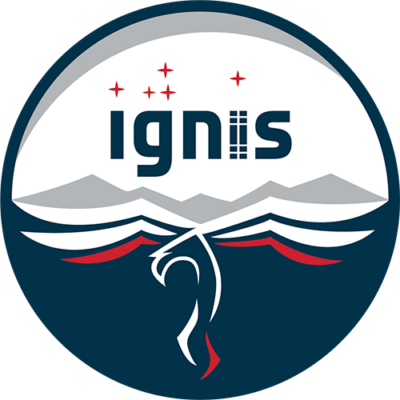IGNIS, meaning ‘fire’, is the official name of Poland’s first technological and scientific mission to the International Space Station. Today, at the Copernicus Science Center in Warsaw, not only was the official name of the mission unveiled, but its key objectives were also presented. ‘This is a tremendous opportunity for the Polish space sector to develop unique competencies and accelerate the commercialization of space technologies’, emphasized Minister of Economic Development and Technology, Krzysztof Paszyk.
‘The mission to the International Space Station, featuring Polish astronaut Dr. Sławosz Uznański, has been officially named IGNIS, meaning ‘fire’ in Latin. This name symbolizes energy, creativity, and passion, which form the foundation of our efforts and this groundbreaking project. The Polish mission is a technological and scientific endeavor that aims to benefit not only Poland but the international community as well. With the involvement of Polish companies and scientific institutions, the mission will carry out experiments expected to advance medicine, biology, engineering, and space technologies. Notable examples include studies on the human microbiome, testing innovative materials, and exploring projects in artificial intelligence. This is a significant opportunity for the Polish space sector to build unique competencies and accelerate the commercialization of space technologies’, emphasized Minister of Development and Technology Krzysztof Paszyk during the conference, where the name and symbol of Poland’s manned mission to the International Space Station were unveiled.
‘We are celebrating the first Polish technological and scientific mission to the International Space Station. This mission is a testament to Poland’s dynamic growth in space technology and its increasing role as a trusted partner of ESA. It exemplifies international cooperation and ESA’s commitment to advancing technologies through commercial access to space. Together, we are preparing for a future beyond low Earth orbit, showcasing Poland’s capabilities and the strength of our shared ambitions. I would like to express my gratitude to the Ministry of Economic Development and Technology for entrusting ESA with this important endeavor’, noted European Space Agency Director General Josef Aschbacher.
Ax-4 mission
This mission will be part of the Axiom mission 4 (Ax-4) and assigned to this mission is Sławosz Uznański, selected as a member of the ESA Astronaut Reserve in November 2022 after a year-long selection process. He became an ESA project astronaut on 1 September 2023 for training familiarisation in anticipation of flying on a future space mission.
Ax-4 will be the second commercial human spaceflight mission with an ESA project astronaut. Financed by the Polish government and supported by ESA, this mission includes an ambitious technological and scientific programme with several experiments proposed by Polish space industry.
For this mission, ESA project astronaut Sławosz Uznański will serve as a mission specialist under the command of Axiom Space’s Director of Human Spaceflight and former NASA astronaut Peggy Whitson. This flight will make Sławosz the second Pole in space, and the first to go to the International Space Station. The assigned crew also includes pilot Shubhanshu Shukla from India and mission specialist Tibor Kapu from Hungary.
While awaiting final approval from the Multilateral Crew Operations Panel (MCOP) for their mission to the Space Station, the Ax-4 crew is undergoing rigorous training at facilities worldwide. This includes ESA’s European Astronaut Centre in Germany, as well as at facilities operated by Axiom Space, NASA and SpaceX in the USA, and JAXA in Japan, to equip them with the skills and knowledge needed for the mission. They will be launched on a SpaceX Falcon 9 rocket, travelling to the Space Station in a SpaceX Dragon spacecraft.
Scientific experiments during the IGNIS mission
During the 14-day mission, the crew will conduct research in microgravity conditions on topics such as astronaut health, the microbiome, new materials, and technologies, including the use of artificial intelligence. They will also participate in educational activities.
‘The Ignis mission is a groundbreaking event not only for our space sector. Thirteen Polish experiments in the fields of technology, biology, medicine, and psychology, prepared by Polish scientists and engineers, will open new opportunities for Polish research and, in the long term, increase Poland’s competitiveness on the global market. ESA project astronaut Dr Sławosz Uznański will be the second Pole in space, making him the best ambassador for Polish science and industry, as well as an inspiration for future generations’, says Prof. Grzegorz Wrochna, President of the Polish Space Agency.
‘Naming this mission Ignis symbolises the spark of innovation and the ambitious contributions from Poland to space exploration. The partnership between ESA, Poland and Axiom Space marks a significant milestone for commercial human spaceflight, enabling the second mission with an ESA project astronaut and highlighting Europe’s readiness to advance space exploration, strengthening its role in shaping the future of space technology’, said Daniel Neuenschwander, ESA’s Director of Human and Robotic Exploration.
The Ignis mission patch
Patches are an integral part of every astronaut mission. Space agencies print out a cloth reproduction that astronauts wear during their flight, a tradition that started six decades ago. These emblems tend to reflect the space flyer’s personality, the mission goals and the creativity of an artist. The Ignis mission, named after the Latin word for ‘fire,’ symbolises the spark igniting a new era in Poland’s space endeavours.
The central motif of the patch features an eagle – a reference to the emblem of Poland – in white and red, reflecting the colours and design of the Polish national flag. Its tail gracefully evokes a flame, while its outstretched wings trace the contours of the Orla Perć mountain range in the Polish Tatra Mountains. Within the mission’s name, the second ‘i’ takes the form of the International Space Station. Above it, stars converge to form the Scutum Constellation, paying homage to astronomer Johannes Hevelius (1611-87), who was born in the Polish city of Gdańsk. Finally, a silver line represents the horizon, signifying the dawn of a new era in space exploration.
Read more: plinspace.pl
The Ignis mission, named after the Latin word for ‘fire,’ symbolises the spark igniting a new era in Poland’s space endeavours.
Ignis is a technology and science mission. As part of it, the European Space Agency’s (ESA) project astronaut, Pole Slawosz Uznański, will conduct a series of experiments proposed by Polish industry and space science specialists and developed in cooperation with the ESA.
The central motif of the mission’s patch is a red-and-white eagle that is an unmistakable reference to the Polish emblem and national colors. The eagle’s outspread wings form the contours of the Tatra Mountains, or more precisely, the Eagle’s Path. Meanwhile, the shape of the eagle’s tail resembles a flame. In the mission’s name – Ignis – the second letter “i” takes the form of the International Space Station. Above, the stars are arranged in the Scutum Constellation. This is a tribute both to Polish tradition and to the great Gdansk astronomer Jan Hevelius (1611-1687). The silver line at the top of the patch symbolizes the horizon – the dawn of a new era in space exploration.








 Back
Back






